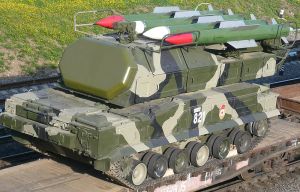Continuing with reaction to Ground Troops CINC, General-Colonel Postnikov last week . . .
Speaking to a RIA Novosti press conference, Director of the Ministry of Industry and Trade’s (Minpromtorg) Defense-Industrial Complex Development Department, Igor Karavayev answered Postnikov this way:
“Unfortunately, we are encountering unwarranted criticism of the tactical-technical characteristics of Russian military equipment lately. Allegedly, it doesn’t match its international counterparts. An objective evaluation of the characteristics and tests conducted, but also the pace at which our exports are growing, attest to the contrary.”
He said more than a few countries buy Russian tanks, and the T-90A got a positive evaluation from testing in difficult climatic conditions, including in Saudi Arabia, India, and Malaysia. In Saudi Arabia, according to Karavayev, the T-90A was the only tank to destroy more than 60 percent of its targets after a road march. Karavayev continues:
“The tests conducted in Saudi Arabia as part of an open tender fully and completely contradict the Glavkom’s [Postnikov’s] assertions.”
This T-90 modification supposedly has a new turret, a 1,000-hp engine, an improved thermal sight, new active defense measures, and a number of other improvements. Karavayev flatly said neither the German Leopard, French LeClerc, nor American Abrams is equal to the T-90:
“So to talk about how our tanks are worse than Western equivalents is not completely reliable information.”
“The price Postnikov quoted exceeds by approximately one and a half times the price at which the producer is ready to supply the vehicle [tank] to the troops. This situation requires additional professional discussion.”
So that’s about 78 million vice 118 million rubles per T-90.
Izvestiya talked to Uralvagonzavod’s chief armor designer, Vladimir Nevolin, who said:
“The main complaints against the T-90 today are connected with its insufficient survivability. Its deficiency is the placement of people, weapons, and fuel in one compartment. In any case of armor penetration, the igniting of fuel is unavoidable. Even with a fire suppression system, such a possibility isn’t excluded. Therefore, the development of modern armored equipment is going the way of separating people from the fuel and munitions. Moreover, the employment of remotely-controlled armaments is essential. These principles were implemented in our future product – “item 195.” For example, on it, the tank turret no longer had the crew. But it turns out no one needed such a project.”
Vesti FM asked Igor Korotchenko whether Postnikov’s claim that Russian arms aren’t up to snuff is true. He said there are objective problems with Russian-designed weapons, and some planned for introduction are really obsolete. But, according to Korotchenko, the Defense Ministry’s main criticism is that Russian combat vehicles don’t meet survivability requirements.
At the same time, Korotchenko says Russia can’t fall into dependence on the West. New armor has to be financed and put into serial production. Limited purchases of Western military technology and licenses for the newest thermal sights and munitions are acceptable in his view, he says Russia’s national technological base for producing major weapons needs to be protected.
Finally, it was Viktor Baranets’ turn in Komsomolskaya pravda.
Baranets noted Postnikov complained quite openly about Russia’s weapons for a military leader of his rank. And he opined that Moscow is not only competitive, but superior in some military systems. But Baranets claims the T-90 cost has doubled from 60 million rubles two years ago due to higher electricity and metal prices as well as adding expensive French or Israeli thermal sights. Nevertheless, says Baranets, Postnikov exaggerated about buying Leopards for the price of a T-90.
Baranets also interviewed Mikhail Barabanov.
Barabanov says the T-90 really is the 17th modification of the T-72, initially called the T-72BU, but T-90 sounded more modern, at least in 1992. The T-90A has grown old, but could still be updated with a new turret, gun, and weapons control system. The 118-million-ruble pricetag comes from a small production run, and it’s steep for a tank that’s not the most modern.
Barabanov says for 118 million you could only buy 3 1980s-vintage Leopard-2A4 from the Bundswehr reserve. And such tanks don’t have any particular advantage over T-90. A new Leopard-2A6 is more than $4 million, but with service, training, spares and munitions, it can’t be obtained for less than $10 million.
Baranets asks Barabanov if the share of modern ground armaments really be brought up to 70 percent by 2020. The latter says:
“It’s realistic given fulfillment of the State Program of Armaments. But its [the GPV’s] fulfillment depends first and foremost on the country’s capacity for high economic growth rates.”


